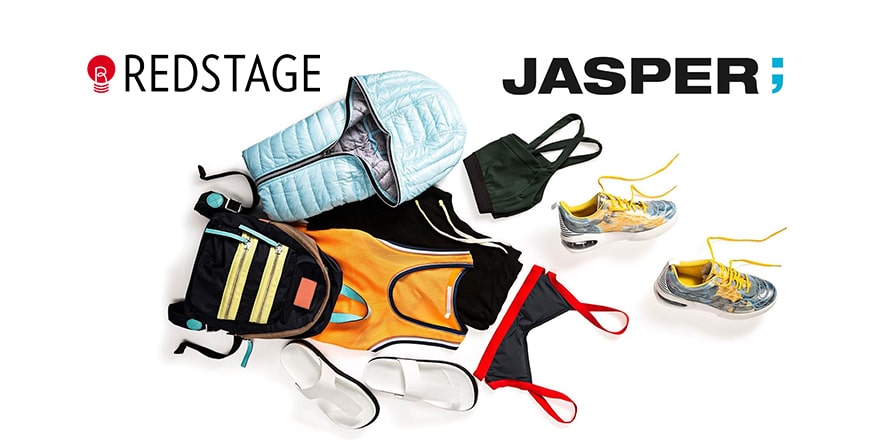
by Jose Suarez | Jun 23, 2020 | Press, System Integrations
In our industry, the creation of solid, valuable, and lasting partnerships is critical to our success. At Redstage, we prize the work we do with our partners, especially those that go above and beyond. This month, we want to highlight the incredible work of the Jasper team and thank them for continuously delivering in what has become one of our strongest and most valuable partnerships. We partnered up in 2019 when Redstage became an officially certified Jasper PIM software reseller and integrator. Learn more about how we work together on Jasper’s blog here.
“With its time-honored industry experience, Redstage is assessing product information needs of online retailers and helping Jasper PIM resell our powerful PIM solution to boost retailers’ online sales and marketing.”
–Jon Marsella, CEO & Founder, Jasper PIM
What is a PIM and why is it critical to eCommerce?
PIM stands for Product Information Management software. Managing your product data across the web on multiple channels can be daunting, but it’s also a vital part of staying competitive in eCommerce. A PIM allows you to manage all of your product information from one dashboard with one backend. Whether you have products across multiple marketplaces, multiple websites, or even in multiple languages, a PIM allows you to keep your product information consistent and updated throughout your online sales channels to strengthen your omnichannel marketing.
Before using PIM systems, online retailers struggled with updating data in massive excel sheets or multiple platforms (like eBay, Amazon, Etsy, Rakuten, and more) or in the right language or price for different markets. With the right PIM, online retailers and vendors can unburden themselves from the time-consuming hassle of logging in to multiple websites and updating product information in numerous digital locations.
You may be asking, “Why implement a PIM?” Or, “How can we calculate the return on investment of a PIM implementation?” By decreasing item returns thanks to accurate product information, increasing your conversion rate, and expanding to other marketplaces and sites with updated product information, you can see huge boosts to revenue across the board. PIM also helps online merchants maintain product authority no matter where your products are featured or sold.

The Jasper Difference
With Jasper’s industry-leading PIM solution, business owners can simplify their eCommerce product management and grow into very successful merchants. Jasper’s motto is “Save Time. Save Money. Earn More.” and these phrases perfectly exemplify the core benefits a PIM software can have.
Jasper PIM saves time by ending the need for long product information spreadsheets, saves money by increasing productivity and lowering the number of mistakes made, and allows you to earn more by increasing conversion rates and lowering item returns.
Results and Success Stories
Having worked with Skullcandy, FitBit, Sherriltree, and more of the biggest brand names in eCommerce, Jasper has proven itself as one of the leading PIM solutions in the industry. Whether you manage products on 1 website, or more than 20, Jasper PIM provides multiple PIM solutions that can be tailored to your needs, ensuring your business’ success.
Jasper’s world-class SaaS product information manager works for both B2B and B2C merchants and integrates into any Magento, BigCommerce, or Shopify store.
Check out how Jasper worked with headphone manufacturer SkullCandy to align their product information in 6 languages and 4 different currencies with their extremely powerful PIM solution here.
Learn More
To learn more about Jasper, contact them, or view more success stories, visit their listing on our partner page here. We’re proud to be part of such a collaborative and productive partnership. Thank you to the Jasper team for your continued support!

by Latoya Young | Oct 15, 2019 | Commerce Strategy, System Integrations
As Thanksgiving quickly approaches, retailers and e-marketers have a lot on their minds. With touchpoints coming from multiple directions across your customer journey, it’s easy to overlook critical components that can immediately affect your revenue goals. To keep you on track, we created this holiday roadmap that covers every part of your funnel. Grab some hot chocolate, scroll through our list, and rest easy while your holiday sales jump like Jordan.
1. The Difference Between Good & Great Content.
There are multiple ways to leverage content to hit different audiences. However, doing so well enough to generate leads, encourage customer loyalty, upsell, and build trust can prove challenging. In these 3 blog posts, we share a few gems to help you produce content that engages and will continue to drive value far beyond the holiday season. If your content marketing strategy doesn’t utilize these key principles, it’s not too late to inject them into your plan. Take a look and maybe grab an idea or two to spice up your content.
Content marketing should be a major cornerstone in your marketing arsenal. By providing valuable, free content, that builds customer empathy, you will attract and convert new prospects into brand-loyal customers. The caveat to producing great content is having the foresight to produce content that aligns with customer interests, while continuously delivering new content that your customers hunger for.
— Christopher Yin, Creative Director, Redstage
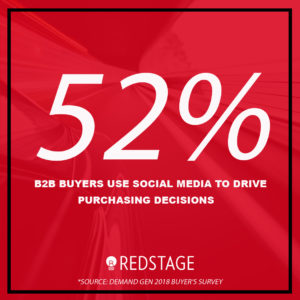
Key Take-Aways:
Know your audience and create content that hits them on a personal level. What are their interests and hobbies? What are the causes they care about? With a more complex buying process, B2B companies may want to consider producing content that hists each part of the sales funnel. Are you helping your audience think critically about the industry? How can you make your customers better-skilled professionals Furthermore, how can you align your brand with these things in a way that’s authentic and true to your brand?
The Difference Between Good & Great Content Marketing.
Top 5 Trends in B2B Personalization & Social Selling.
What Prime Day Can Teach Us About Holiday Sales.
2. How to Stop Your Store from Crashing
Thanks to your engaging and authentic content, customers are flocking to your store. Lucky for you, holiday spending is expected to increase by 5% this year, but most customers won’t be visiting your physical location. More than half (around 53%) of your holiday customers will shop exclusively online. This surge in traffic has the potential to cause a lot of stress on your server, causing crashes or bugs that leave your customers aggravated or empty-handed.
You’ve worked hard to build trust and develop customer loyalty, you can’t fail them now, and with our help, you won’t.
The holidays are a time of increased profits, but that comes with a huge load on websites. So if you haven’t done proper stress testing to account for higher demand, you won’t know how your online store is going to react.
— Adam Morris, CEO at Redstage
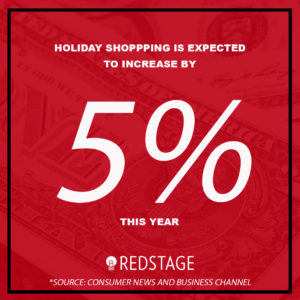
Key Take-Aways:
Proper preparation prevents poor performance. Your customers won’t let you off the hook if you give them a poor experience, especially if you’re a wholesaler or manufacturer who has an inaccurate count of inventory. Twitter can be your best friend or worst enemy. Check out these articles to ensure you stick with the former by properly monitoring your site and completing our performance checklist. These 4 articles will help you optimize and digitally strengthen your store for the holidays.
Ghosts Of Black Fridays Past: 3 Crucial Warnings For Retailers.
Black Friday Countdown: 4 Critical Last-Minute Store Optimizations.
Black Friday Countdown: 8 Omnichannel & Back Office Final Touches.
Q&A with Redstage’s Adam Morris: Prep for Black Friday 2018.
3. How To Unlock More Mobile Holiday Revenue
By now you have done the research and collected the data. You know your customers’ buying habits, likes, and dislikes. You now only have 1 shot and a couple of seconds to impress them with frictionless and secure customer experiences. 32% of consumers change their minds about making a mobile purchase by abandoning their carts. Getting this step right can potentially cut your mobile cart abandonment in half. A part of stress testing your site is assessing your checkout funnel and you can do so with the Mobile Optimization Initiative. This blog can get you thinking with a mobile-first customer experience mentality so that you are not missing out on your share in over $500 billion.
Smart A/B testing based on data-driven analysis gives you insights that lead to successful, simple changes that can have a big impact on increasing your revenue per visitor.
— Benjamin Shapiro, Solutions Engineer, Redstage
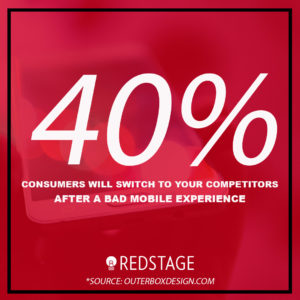
Key Take-Aways:
Doing it right the first time can save you the trouble in the end. Potential consumers and corporate buyers want to check out with ease, the sooner you begin simplifying the check-out process the better your site will perform The sooner you start, the better your site will perform. Better performance means staying one step ahead of your competitors.
How to Unlock More Mobile Holiday Revenue.
4. How to Defend Your Store from Cybercriminals
You have done your due diligence and can sit back and enjoy your holiday. Not exactly. While customers are increasingly shopping online, there is a huge risk that their data can be exposed. You may have heard of some common hacks such as phishing, payment fraud, and account take over. With an expectation of a $22 billion loss this year due to fraud this section is a must-read. Here you will find the top 3 tactics hackers will use to attack your eCommerce site and how to keep your store and customers safe. We also joined forces with our trusted partner Trustpilot to give you 7 ways to improve your website’s trust signal.
Merchants need to start with an honest evaluation of what fraud costs your company. This isn’t just the money you lose on fraudulent orders you ship; it also includes all the time your staff puts into screening orders as well as the revenue lost to rejected orders which may have been safe. When you add up all these costs, the price of top fraud prevention solutions starts to look a lot more attractive.
— Oliver Sosinsky, Sr. Solutions Engineer, Redstage.

Key Take-Aways:
Your customers deserve the same amount of protection as your store and protecting their privacy must be a priority. Monitoring is both crucial and necessary in keeping your customers and store safe. However, investing in a well-vetted Anti-Fraud Solution can ease your worries.
7 Ways to Improve Your Website’s Trust Signals.
3 Tactics Hackers Will Use Against eCommerce Store Security This Holiday.
3 Stopgaps to Ensure Your Holiday Strategy Goes As Planned…
Ready or not, the holiday rush is coming, and it is up to you to properly prepare. B2C companies are rising at a steady pace and facing many challenges starting at the top of the sales funnel. However, B2B companies can learn a thing or two as they play a key role in ensuring B2C’s and their customers are benefiting from their product or services. Customers and their unpredictable demands and expectations are inevitableTo produce a safe, frictionless, shopping experience, both B2B and B2C companies must work in sync to increase conversion.
Whether it be online or a brick and mortar, your ultimate goal for this holiday season is to make a profit while increasing brand loyalty. If you want to stay ahead of your competitors here are 3 action steps, you should take.
- Learn more about the Mobile Optimization Initiative and sign up for a free consultation here.
- Schedule a free consultation to find out what testing feature is best for your site here.
- Schedule a consultation to find out which security bundle fits your site’s needs here.

by Don Pingaro | Sep 21, 2019 | Commerce Strategy, System Integrations
Congratulations! You survived the Back to School retail surge. While the true test of eCommerce performance is yet to come, any hurdles you encountered during Back to School should be taken care of well before then. Consider these your warning shots. To help, here are 3 precautionary measures you can take to digitally strengthen your store for the holidays.
1. Stress Test to Avoid Lost Revenue
A wave of more than 6.2 billion shoppers will descend on digital retailers during Cyber Week. Unfortunately, not all businesses are prepared for success…
For example, J. Crew’s site crashed on Black Friday in 2018 and issues persisted throughout the afternoon. Analysts predict the outage cost the company around $780,000 in just five hours. Shoppers flocked to Twitter to complain en masse, causing a firestorm of anger to erupt across the web. This is where the real damage was done. Like a ghost story from holidays past, this is a warning for retailers everywhere to change for the better.

Redstage’s CEO Adam Morris identified the top “holiday rush” issues we’ve helped clients through in years past. Here’s what to watch out for:
1. Slow Site Speed
2. Price Caching
3. Broken or Buggy Checkout
4. Server Overload or Timeout
5. Add to Cart Features Failing
“The holidays are a time of increased profits, but that comes with a huge load on websites,” Morris says, “So if you haven’t done proper stress testing to account for higher demand, you won’t know how your online store is going to react.”<span class="su-quote-cite">Adam Morris, CEO at Redstage</span>
Preparing for the worst now can save you money and your reputation later with one simple step— testing. Skipping this step could spell disaster that leaves the specter of poor service hanging over your reputation for years to come.

2. Your Back-End Checklist at Present
From Thanksgiving to Black Friday through the end of Cyber Week, retailers have a few critical days to rake in as many sales as possible. During this shopping frenzy customers both in-store and online. Regardless of how they buy, your online store (or your app) will more than likely be their first stop. We developed a checklist of what you can do today to ensure your eCommerce site survives Cyber Week.
- Optimize your site’s user experience with A/B testing.
- Check your indexing to avoid price caching.
- Review all error codes to avoid a broken checkout.
- Avoid overload and crashes by scaling your server.
- Double-check key functions to avoid important features failing.
- Complete load testing to prepare for an increase in traffic.
- Utilize an automated monitoring system for real-time updates on 404s and checkout errors.
- Upgrade your payments and security platforms to prevent payment fraud.
- Lastly, be prepared to scale up your support team on the fly. If something goes wrong, even for a few minutes, you’ll need a sizable support team to manage angry customers and correct the issues.
“If you’re not using visitor data to identify the friction points in your checkout, you risk focusing your budget in the wrong places. A data-driven approach to optimization means trusting your analytics even when the message is counter-intuitive.”<span class="su-quote-cite">Oliver Sosinsky, Sr. Solutions Engineer at Redstage</span>
Learn a valuable lesson from LuLu Lemon. Last year, the athleisure brand’s site went down the morning of Thanksgiving Day. Shopper outrage hit Twitter at 8am EST with a “Site is down. Ugh!”
In the first minutes of the shopping event of the year, the brand was stuck, entangled in crisis. Once the site got back online, more errors appeared, causing sales prices for in-cart items reset to regular prices or prevent customers from checking out.
With proper bug monitoring and back-end preparations, this fiasco could have been avoided. Take a page out of our book and start monitoring now. You’ve done the legwork to bring customers to your site, now protect it.

3. Capitalize on the Future
A single visitor doesn’t guarantee a transaction and a single transaction doesn’t guarantee a loyal customer. Flawless mobile experiences will do both, but takes some serious testing.
Conversion rate optimization turns your visitors into customers while ensuring they receive an immaculate customer experience. While no two customers are the same, simple tests can lead to enhancements that remove friction from the checkout and dramatically reduce abandoned carts.
Merchants like LawnmowerTirestore.com took advantage of testing their site before the holiday season and the results were a game changer. By making their checkout button stick to the site’s header and follow users while they scrolled, sales soared with a 29.5% increase in revenue per visitor (RPV) for desktop customers. For mobile, the test yielded a 7% increase in RPV, after only 4 weeks of testing. Now, Lawnmower Tirestore plans to roll-out the feature site-wide to capitalize on their new-found data-driven advantage.
As part of the Mobile Optimization Initiative, retailers can receive checkout tests 100% free. The goal of the initiative is to create a set of best practices for mobile optimization and share our insight with the world. Read more about the initiative here.

Final Thoughts
According to Internet Retailer, 60% of consumers plan to spend 50% or more of their holiday shopping online; spending over $21.6 billion during Cyber week.
It is not too late to prepare. If you start early enough and cover all the bases, you can sit back, relax and watch your revenue grow with measurably less stress. Remember, this is your holiday too. While there’s still time, monitor your site for bugs, load test, A/B test, utilize the data, capitalize on those results, and enjoy some eggnog.
Cheers!

by Don Pingaro | Feb 5, 2019 | Commerce Strategy, System Integrations, Web Development
It’s 2019. Accessibility and social justice are everything. As a result, ADA compliance lawsuits are being filed in record numbers, and eCommerce companies are a major target. Here’s the info you need to understand the issue and protect your online business.
ADA Compliance Crackdown
Although the U.S. Department of Justice has delayed the release of the latest federal accessibility guidelines, companies are expected to comply with the Web Content Accessibility Guidelines (WCAG) 2.0 AA. Resulting from this lack of federal guidance, users with disabilities are lawyering up against even the biggest online behemoths.
Among these, Amazon, Apple, and Nike have been called out for failure to comply with Title III of the Americans with Disabilities Act, along with hundreds of other businesses, driving a torrent of actions.
According the the Bureau of Internet Accessibility, there were ”at least 814 federal web accessibility lawsuits filed in 2017, but an assessment of the issue by ClassAction.org shows the number of lawsuits [filed] in 2018 may far surpass that number.”
In fact, in the first two months of 2018, roughly 200 different ADA lawsuits were filed against websites, at which point retail law advisory Goulston & Storris announced there was “No Relief in Sight”.
While it remains unclear just how many lawsuits have been brought since last March, it is expected for this surge in suits to continue.
Why Haven’t I Heard About This?
If you haven’t been targeted yet, chances are you know someone who has. If not, the reason you haven’t heard about this is simple: The Wayfair case. The recent explosion of content on the Supreme Court’s South Dakota v. Wayfair decision incited a media frenzy that circled eCommerce’s corner of the web, from top news agencies to the smallest tech blogs. With the industry distracted by a wide-reaching tax-compliance issue —and retail giants like Nike keeping tight-lipped about their lawsuits— the compliance issue has remained largely under the radar.
In 2018, more than 13,000 suits were filed over online ADA compliance as of October, with eCommerce playing a large role. It’s not the issue alone that’s troubling, it’s the rate at which suits are being brought that’s startling. Last year, 7663 suits were arraigned in federal court, which at the time was a 16% increase over the previous year (see chartL ADA Title III Lawsuits in Federal Court: 2013-2017).
With an ever increasing number of lawsuits looming on the horizon, the industry may face a 20% increase over last year for 2019. “I spoke with someone about these suits during Magento Imagine 2018. Just as the conference was ending, they received an email saying their own site had been targeted and served an ADA suit.” Adam Morris, Redstage CEO said. “eCommerce companies should make accessibility a priority for the year ahead.”
Can My Site Be Next?

While a discriminatory class action suit could spell disaster for any company, the first step is identifying the types of companies that fall into the legal crosshairs. According to the Americans with Disabilities Act, these company categories are as follows:
- Businesses engaged in an industry affeciting commerce (Title I)
- Businesses with 15 or more full-time employees (Title I)
- Businesses operating for 20 weeks or more every year (Title I)
- Businesses categorizes as “Public Accommodations” (Title III) including:
-Inns, hotels, and motels
-Restaurants and bars
-Bakeries and grocery stores
-Hardware stores or any sales/retail outlet
-Banks
-Laundromats and dry cleaners
-Accountants and lawyers’ offices
-Health care providers’ offices
-Public transportation
-Recreation venues
-Schools
-Social service centers
-Gyms
While the ADA compliance is primarily focused on physical locations, Title III states that barring access to people with disabilities in the private sector is discrimination, which encompasses websites. With 15% of the global population living with some form of disability (41M+ Americans), and online shopping being so prevalent – think Black Friday – companies are losing business due to inaccessible websites and continuing to run the risk of being served an accessibility lawsuit.
How is Redstage Being Proactive?
Redstage recently partnered with Siteimprove, an all-in-one software that provides the insights needed to address issues relating to accessibility, as well as SEO, content quality, brand compliance, data privacy, and more.
“The Siteimprove and Redstage partnership is one we’re extremely excited about given our common goal of positively impacting web accessibility.” Siteimprove Sales Director Ted Goldberg Said. “We’re looking forward to working together to help facilitate increased accessibility for their client’s sites as well their own.”
The Redstage team is excited about this partnership, as Siteimprove’s automated accessibility checks help identify website elements that violate WCAG 2.0 guidelines, while also organizing those issues into a prioritized list. By partnering with Siteimprove, Redstage will be able to mitigate risk for our clients while building a strong, overall accessibility strategy.
Conforming Your Site to ADA Compliance
At Redstage, we’ve already had our fair share of engagements with merchants facing ADA lawsuits. “Our clients are seeing increased pressure from legal trolls targeting them because they are not ADA compliant.
The ADA compliance rules are vague at best, so companies with an eCommerce channel should have an informed partner to help them.” Redstage CEO Adam Morris explained. To mitigate this risk, Redstage is working with specialized authorities in the ADA field to give clients and readers a comprehensive ADA compliance report.
“ADA compliance contains many elements of a great UX strategy,” says Adam Piken, Redstage’s Creative Director, “Your site should be user-friendly and intuitive, allowing customers to find buttons, check out, get your phone number, or type a question into your live-chat quickly and easily.” In this way, ADA compliance is reinforcing activities eCommerce companies should already be doing.
Most importantly, ADA compliance takes considerable design alterations in most cases, so the best time to get compliant is during your next redesign or site migration. If you’ve been following along with our Magento 1 End of Life Initiative, we recommend putting ADA compliance at the top of your Magento 1 to Magento 2 migration checklist.
Get Your ADA Compliance Check Now
If you think your site is at risk of being targeted, email us and we’ll get you set up with a team of experts to help identify and eliminate potential access barriers that may impede access and usability for your users, while safeguarding your business from legal action.

by Don Pingaro | Jan 29, 2019 | Commerce Strategy, System Integrations
Happy New Year! With 11 months of heavy-lifting ahead of you, there’s no better time to work smarter. To help, we’ve compiled this list of 5 Omnichannel Resolutions to incorporate into your 2019 eCommerce strategy. There’s a lot here, so bookmark this page and subscribe to ensure you’ll never miss a tip that will give your brand a competitive edge.
#5: Monitor & Group KPIs for Data-Driven Decision Making
Here’s a short list of the standard KPIs that marketers, operations professionals, and eCommerce managers use. Most, if not all of these should be familiar to you. We put them into a few separate buckets that help achieve specific goals. Our team recommends organizing them in a similar way, as each can help you create a simple report rather quickly, and each tells a very different story. Even if you have software that does this for you, putting stats in different tranches like this can help you identify key trends you can act on. Hover over KPIs for individual calculation formulas.
Customer Engagement KPIs
These KPIs allow you to see at a glance how your site is performing:
- Conversion Rate (CR)Conversion Rate# Sales / # Clicks
- Average Order Value (AOV)AOVRevenue / # Orders
- MVP/VIP AOV (AOV of your most valuable customers)MVP AOVRevenue / # MVP Orders
- Customer Lifetime Value (CLV)CLV(Avg. Perchase Value x Avg. Purchase Frequency Rate) x Average Customer Lifespan
- Cart Abandonment RateCart Abandonment Rate# Completed Purchases / # Carts Created
- Browser Abandonment RateBrowser Abandonment Rate# Completed Purchases / # Unique Sessions
- Churn RateChurn Rate# Customers Lost / # Original Customers
- Site Traffic
- Mobile Site Traffic (Make sure you’re using this in 2019!)
- Returning vs. New Visitors (includes non-converting traffic)
- Returning vs. New Customers (excludes non-converting traffic)
- Page Views Per Visitor
- Newsletter Subscribers
- SMS Subscribers
- Site Uptime %
Budget Management KPIs
Here we have a short list of “must-have” budget-oriented KPIs:
- Cost of Goods Sold (COGS)Cost of Goods SoldBeginning Inventory + Purchases During the Period – Ending Inventory
- Gross ProfitGross ProfitSales - Cost of Goods Sold
- Average Margin
- Customer Acquisition CostCustomer Acquisition CostMarketing Spend (over a given period) / #Customers Acquired (over a given period)
- Return on Ad Spend (ROAS)Customer Acquisition CostAd Spend / Ad Revenue
- Return on Investment (ROI)
- Fulfillment Costs (Especially Cost of Returns)
Customer Feedback KPIs
There are additional customer-facing stats you should keep an eye on, which help identify how your customers feel about your products, service, user experience, and more. Under analysis, these metrics are helpful for determining where friction occurs in the buying process. For example:
- Customer Satisfaction Score
- Net Promoter Score
- Customer Service Avg. Response Time
- Customer Service Call Count
- Customer Service Email Count
- Customer Service Chat Count (for those with chatbots)
- Average Customer Service Rating (if you have surveys after chats, emails or calls)
- Average Customer Sentiment (with tech like YOTPO, you can gage overall review sentiment)
- Google Reviews Rating (if applicable)
- Yelp Reviews Rating (if applicable)
- Top 10 Products
- Worst 10 Products
- Top 5 Service Strengths
- Top 5 Service Weaknesses
- Number of App ‘Superusers’ (Customers who use your app every day)
Tracking Revenue Per Visitor (RPV)
In 2018, a relatively new KPI began gaining recognition in the market. Revenue Per Visitor (RPV) has been called “the most valuable metric” for gaging online sales performance, and is especially helpful when it comes to A/B testing. To find your RPV value, multiply your conversion rate by your average order value. This gives you an estimate of how much the average customer is spending.
#4: Make A/B Testing A Habit

A/B testing is invaluable. In an age where data-driven decision making has the highest ROI, companies who make experience alterations on a whim are falling behind. Whether its email subject lines or adding a PayPal Express Checkout button, merchants should be testing these changes with sample groups before making them across the board. Do your due diligence and add A/B testing to this year’s resolutions (especially for Mobile optimization).
Mobile Checkout Testing
Throughout 2018, we tested a variety of mobile checkout enhancements, eventually culminating in the global Mobile Optimization Initiative, now open to Magento merchants everywhere. After running tests on the mobile checkout experiences of more than 20 merchants, we noted several key trends, but one stood above others: The need for merchants to A/B test constantly.
“Some of the changes we assumed would have a big boost to revenue had very little effect and vice versa. It really highlighted the value in making data-driven decisions rather than going off conventional wisdom.”<span class="su-quote-cite"><a href="https://magento.com/blog/best-practices/mobile-optimization-initiative-key-findings-and-why-they-matter" target="_blank">Oliver Sosinsky, Redstage Solutions Engineer</a></span>
Every site is different, and more importantly, every audience is different. While some tests revealed huge opportunities for brands to rake in more dollars on mobile, the same tests flatlined or even resulted in a downturn for other merchants (in a few cases). As the race to close the mobile conversion gap continues, our top piece of advice is to start designing digital experiences for mobile users specifically. Most importantly, merchants must work to understand what their mobile customers expect and how to simplify experiences to match. If you’re interested in learning more about the initiative or getting some of your own mobile experiments in motion, sign up here.
“In a world where responsive design is trying to give [customers] all the same functionality we have on desktop in mobile, there may be a divergence here where we have to start thinking about different mobile-first customer experiences.”<span class="su-quote-cite"><a href="https://magento.com/blog/best-practices/mobile-optimization-initiative-key-findings-and-why-they-matter" target="_blank">Adam Morris, Redstage CEO</a></span>
#3: Create Rich, Interactive Brand Experiences

Creating & Curating Today’s Most Resonant Brands
Traditional retail has hit rock bottom. While Sears and Toys ‘R Us are two of the best known casualties, the implications stretch to each and every physical store on the planet. Both retail giants suffered at the hands of decisions that went against their customer experience. For Sears, the decision to switch to “Everyday low prices” was the first nail in the coffin. Prior to this, the company’s coupon catalog had created buzz and drove customers into stores weekly. Without it, there was little customer experience left, especially with a rapidly decaying in-store experience.
Toy’s ‘R Us was no different. Understaffed stores became empty warehouses. Items were difficult to find in these cold depths, and staff were largely unhelpful when it came to navigating the superstores. Eventually, there was no reason customers wanted to go visit physical locations. With other toy retailers offering better prices online, it was easy for the customer base to choose alternative means. Interestingly, in a last-ditch effort to save the brand, Toys ‘R Us created an augmented reality app. With the app, customers could quickly find the products they were after, and kids could play mini games, test out toys, and go on scavenger hunts around the store, guided by an animated giraffe (the company’s mascot). Unfortunately, it was too little too late, but what are today’s resonant brands doing to keep customers engaged?
The In-Store Experience Revolution will Dominate 2019
Amid cries of 2017’s “Retail Apocalypse,” we made a series of predictions for 2018. In an article titled AR & AI: The eCommerce Armsrace we anticipated a revolution for in-store experience technology.
“If Snapchat can already morph your face and add eye-shadow, will brands like Ulta Beauty and Maybelline step up to the challenge?”<span class="su-quote-cite"><a href="https://redstage.com/conversion/ar-and-ai-the-eCommerce-arms-race/" target="_blank">Don Pingaro, Marketing Coordinator, Redstage</a></span>
Interestingly, while we were wrong about which DTC giant would debut this tech, we were right to suspect its prompt emergence in the market. In early December, Covergirl shook the global beauty sector by installing an “Experiential Makeup Playground” in its Time Square flagship store. The store uses the latest connected retail technology, including voice, IoT, and augmented reality to let customers ‘try on’ products via smart mirror “glam stations.” Expect the company’s rivals to shortly follow suit.
Brand Loyalty and the Immersive Retail Experience

Nike took a similarly immersive approach with in-store experience upgrades at its first “Nike Live” store on Melrose Ave. in L.A. As soon as shoppers enter the store, geofence technology recognizes the presence of the app on their smartphone. From there, Nike’s customer algorithm will give product recommendations based on shopper stats, style and shoe size. Among the rich, app-driven incentives, Nike will even automatically reserve a pair of shoes customers might like. When customers buy Nike products online, Nike ships them to personal smart lockers in-store that can be accessed simply with a Nike+ member pass. No friction, no waiting, no problem.
“[I]n the heart of West LA is also the first Nike Live concept store that blurs the line between digital and physical shopping. Powered by Nike digital commerce data, everything about the store is designed to work seamlessly with the Nike Plus app on shoppers’ phones.”<span class="su-quote-cite"><a href="https://www.fastcompany.com/90201272/nikes-new-concept-store-feeds-its-neighbors-hypebeast-and-dad-shoe-dreams" target="_blank">Fast Company</a></span>
The Digital “Show Room”
Both Nike and Covergirl ushered in amazing retail makeovers by leveraging customer data to solve common customer challenges. For Covergirl, the new tech helps customers try out products they might not be able to physically test anywhere else. As a second key benefit, the experience encourages customers to try on more makeup during their session than they typically would. Third, because shoppers are using AR, this doesn’t cause physical product waste like the often seen “try me” lipstick in other stores.
For Nike, a key decision to place the concept shop on Melrose Ave. arose from the fact that “one in fifty pairs of shoes sold in the area was a Nike Cortez, which was reflected in the product selection available to customers,” according to the Fast Company article mentioned above. Based on this data, Nike responded by creating a store where customers could get expedient access to the newest products (which are usually in high demand). The connected retail space also creates a better environment for millennial shoppers who hate interacting with sales staff, something the retail sector has been slow to pick up on.
Experiences like these are the future of brand loyalty. While we predict stores will become more like show-rooms in the coming years, brand experiences like these will drive customer retention & acquisition. The stage has been set for the in-store experience revolution, and the brands that can best serve customers (digitally and physically) will make it known in 2019.
With this push toward immersive brand experiences in brick-and-mortar stores, brands who lack physical locations will need every advantage to ensure a fast, frictionless, and competitive online experience.
#2: Explore and Implement Deep-Personalization

As Apparel Magazine notes, “According to SAP’s Digital Readiness Survey, 75 percent of retailers believe it is important to deliver a valuable, relevant, and personalized experience specific to the consumer. Further, more than 60 percent of retailers believe it’s important to develop context-relevant, personalized recommendations based on consumer sentiment and history.” This rapidly growing trend is why today’s omnichannel push exists. Making your products available to consumers on their favorite platforms like Facebook, Amazon, Ebay and Google is simply a deeper way of aligning brand experiences with the habits of your customer. With this frame of mind, lets explore some additional methods for creating a rich, visible, and convenient brand.
Recalibrate Your Personalization Tech in the Year Ahead
1. PPC, Email, and Remarketing
Revisiting our #4 recommended resolution for the year ahead, A/B testing isn’t limited to the checkout. Review and optimize your lead-attractors, from PPC and remarketing ads to emails, popups, and SMS. Take a good, hard look at your targeting and make sure you’re using your data to its optimal effectiveness. Test out a revitalized approach to mobile advertising. Investigate your messaging effectiveness between channels. Is the message consistent? Should it be? Have your customer expectations changed? Are customers more responsive to different messaging on different channels or devices? Would you consider creating new PPC ad groups by repurposing your best email subject lines of 2018? Analyze, experiment, evaluate, and optimize.
2. Voice Search Marketing
Comscore predicts half of all online searches (or more) will be conducted via voice by 2020. Despite more than 100 million Amazon Alexas being sold to date, voice search only accounted for a measly 0.4% of online sales in 2018. However, $2.1 billion in sales is nothing to ignore. Between 2016 and 2017, voice search went from zero to 10% of all search volume. Today, more than 20% of searches have voice-based intent. Moreover, smart speakers are predicted to penetrate more than 55% of homes by 2022, a figure that doesn’t account for digital assistants already embedded in smartphones. With millennials relying more on mobile eCommerce and a growing interest in IoT, 2019 may be the year we see another jump in voice search. It’s time for retailers to get invested as adoption continues to pick up.
3. Video
Video is a marketer’s best friend. Consumers are “anywhere from 64-85% more likely to buy after watching a product video,” and in 2018 the industry began using them in more creative ways. While tutorials, product videos, and UGC have historically driven sales, merchants with content-driven commerce strategies now use video to enhance, repurpose, and revitalize content. Consider creating interview-style videos where users discuss the product with a member of your team. Host a live Q&A on twitter or facebook for popular products, new releases, or products with high views and low sales. Another option is to record video introductions to new or once-popular blog posts to grab additional clicks on social media.
4. Chatbots
Think what you might about chatbots, but visit any merchant site and they likely have one (or at least a live chat). As customer patience becomes paramount, it’s important to give customers immediate help before they bounce. Moreover, make sure you’re optimizing and changing up your automated greetings at a reasonable pace. Setting up automated conversation paths is another promising benefit of chatbots, and programming responses based on keywords can save time for your sales & support teams.
5. Payments
Newly released data from Adobe and Internet Retailer reinforces once again that mobile sales will continue skyrocketing. As we mentioned earlier, payment options and your checkout process in general needs to be more than simply “responsive.” Mobile customers expect frictionless experiences, and as our research shows, are more likely to buy if you offer payment options like PayPal Express Checkout, Venmo, Apple Pay and even Amazon Pay. However, while we’ve seen success across the board for stores that add the PayPal option before regular checkout, every merchant’s audience will have different preferences. Be sure to make mobile wallet testing a priority, especially before Black Friday rolls around again.
6. Shopping Apps
Shopping apps allow merchants a chance to increase brand value, customer retention, and AOV. The promise of better experiences drives app downloads, which in-turn drive sales and customer loyalty. Think of apps as the most targeted remarketing channel brands can use. The ability to send a notification to a customer is one thing, but getting access to large swaths of individualized data is a whole new world. In this way, apps are the pinnacle of personalization, allowing retailers to alert users about products they might like or share reminders about past purchases they may want to replenish soon. Deals and coupons can be shared instantly, and with the average millennial spending 5.2 hours per day on their smartphone, it’s an avenue worth trying out (The average Gen-Z user spends 5.9 hours on their smartphone per day). Customers generally like apps due to their simplified functionality and UI compared to bulky company websites, and with your brand’s logo on their phone, they’ll likely interact with you more often.
Amazon, Customer Service & Social Selling

According to the Future Shopper Report, 68% of shoppers first visit Amazon.com when searching for products. 80% of shoppers compare prices on Amazon when they’re shopping somewhere else. Why? Because Amazon offers a simple and superior shopping experience. If we dissect the eCommerce monolith, the wide variety of products, wholesale prices, and incredibly fast shipping options make it the easy choice for finding just about anything. All things considered, it’s no wonder Amazon surpassed Google for most product searches last year. That said, theres a lot retailers can learn from Amazon, and several ways to fight back.
For starters, Amazon’s rich product information and advanced search abilities make finding the right product easy. All companies from B2B to B2C can make customer lives easier by following Amazon’s model in these areas. Next, Amazon’s customer support is second to none, replacing lost or damaged items immediately, without additional cost to the consumer (shipping included). In light of this, merchants should work to create better returns policies and frictionless customer service.
Another way to combat Amazon is to succeed in both product authority and social selling. As a specialized retailer, you need to prove yourself as a thought leader to rise above the competition. Whether that means having a presence at Fashion Week, getting influencer endorsements, or simply creating compelling and informative content for your blog — you need to earn authority and respect from your users. You can achieve the same effect by reflecting your extensive industry insight in product descriptions and including niche-specific attributes.
Beating Amazon’s customer support may prove tough, so social selling is another good way to fight back. Rather than focusing on reactive customer support, refocus your sales team’s time and energy on starting conversations that earn trust and influence sales. The team at 4-Tell have some great sales enablement tools, including machine learning algorithms for site search and product recommendations. Sales teams can also build custom product boards to share with customers based on shopping habits. Personalization doesn’t get more personal than that.
#1. Prepare for the Global Omnichannel Transition

Thanks to significant buy-in from major retailers, a global omnichannel transition is now underway. In 2019, more industry titans and mid-tier merchants will progress from the planning and building phase to execution. With this comes a threat to smaller retailers who harbor strong digital backbones, now having to fight on all fronts against groups with bigger budgets. What’s more, as a growing number of B2B companies undergo their own digital and DTC transitions, a realization is coming to the fore: Every business must adopt even stronger logistics capabilities. Here’s how:
Fighting “Faster” with “Frictionless”
With Amazon’s Prime Now option, customers can receive last-minute orders within 2 hours in 50 cities across the united states. However, items available on Prime Now are limited to household goods and groceries, with only a select few grocers (aside from Whole Foods) listing their products on the platform. Since most retailers are unable to compete in terms of delivery time, the industry’s best bet is to drive convenience through pervasiveness.
Use (More) Convenient, Shoppable Channels
Ebay, Newegg, Facebook Marketplace, and Etsy are just a few of the many sites where retailers can flex their omichannel muscle. In line with this thinking, retailers need to up their ad game and start creating more enticing shoppable posts on social media. It’s not enough to have a constant stream of social content. Brands need engaging content that resonates with their audience and keeps them coming back. Take a note from Young & Reckless, the Skateboarding brand that achieved a 3x return on adspend through Instagram. By combining influencer marketing campaigns with branded and shoppable posts, they were able to broaden their audience, reach more customers, and keep their products in the spotlight by aligning with trends and celebrities their audience cares about. In fact, half of the brand’s online traffic comes from social media. That’s the value of resonance.
“Companies with omnichannel customer engagement strategies retain on average 89% of their customers, compared to customer retention rate of 33% for companies with weak omnichannel customer engagement.”<span class="su-quote-cite"><a href="https://www.invespcro.com/blog/state-of-omnichannel-shopping/" target="_blank">Invesp</a></span>
Understand Return-Psychology
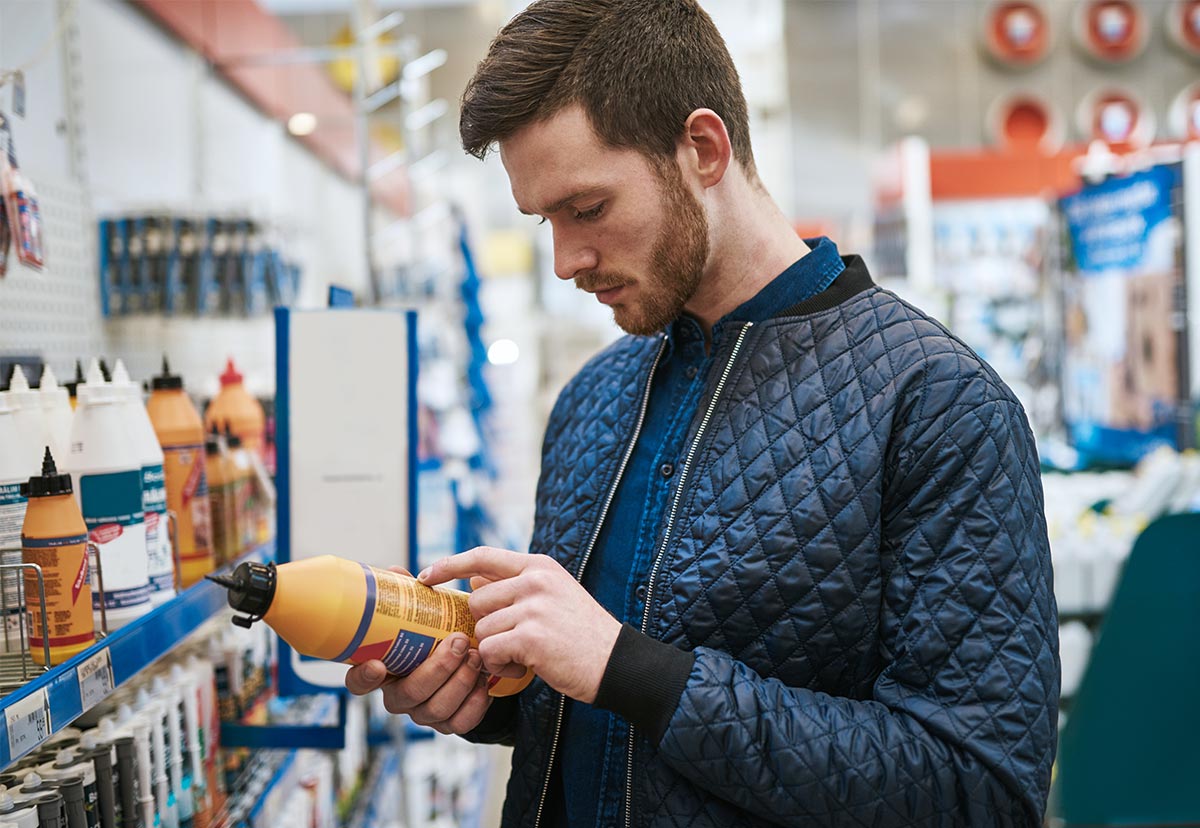
Creating a simple and frictionless return experience was also a key part of Young & Reckless’ success. When customers know you have a safe and sensible return policy (usually with no cost to them), they’re more likely to buy your product. This is all part of eCommerce consumer psychology. Millennials understand the pain of buying something online that turns out to be the wrong size. Next comes the inconvenience of contacting the return center (sometimes a lengthy process), going to the post office, paying for shipping, and sending the product back. Lastly, the customer has to buy the product all over again, only this time, they’re short a few bucks and have to wait for the delivery to arrive all over again.
Having this experience just once might be enough to make customers look elsewhere for the same product, or worse, never shop on your site again. What might seem like a small inconvenience for some is unforgivable in the minds of millennials, who expect the utmost simplicity. When this expectation isn’t met, their trust in the brand is broken. Moreover, as the most cautious customer segment, they may suspect future purchases from your store could result in the same negative experience, compelling them to avoid the risk altogether.
In 2019, retailers should do their best to offer frictionless returns. Your customers will pay you back in spades. Critically review your returns process and policies. Consider using returnable, pre-paid packaging, and if you can, aim for BOPIS options. The Buy-Online, Pick-up In Store revolution is yet another movement born from evolving eCommerce psychology. It not only relieves customer contention points like faster delivery and delivery safety, but gives “bricks-and-clicks” retailers another opportunity to engage with customers in the physical world.
The Wrap-Up
We designed this rather long-winded thought piece for merchants and marketers to vastly enhance customer experiences in 2019. We hope you found some valuable strategies and new ideas to use this year, or at least began to think critically about some aspects of customer satisfaction and engagement you may have overlooked. If you think anything should be added to this article, feel free to share your thoughts in the comments below! If you’re looking for a team of eCommerce veterans to help you achieve your 2019 goals, reach out today to schedule your free project consultation.
















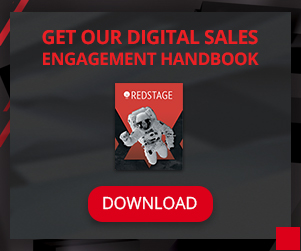







Recent Comments